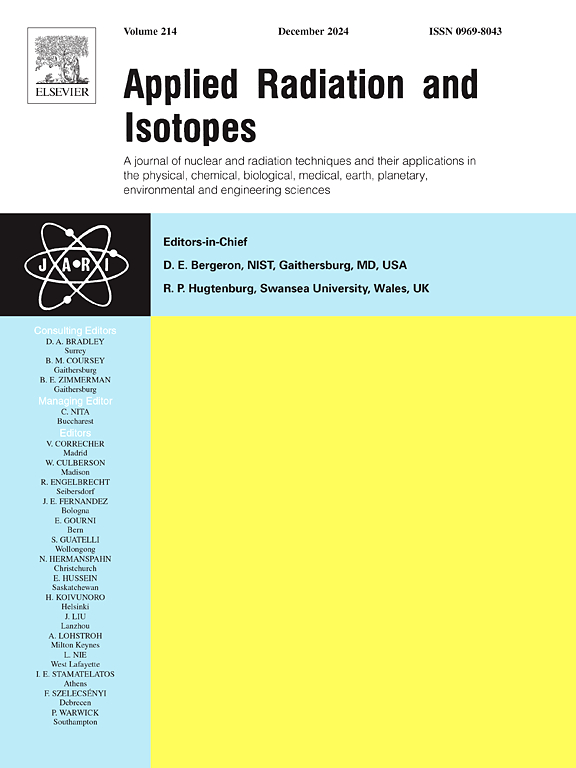67Cu和64Cu两种铜放射性同位素的细胞和多细胞剂量学
IF 1.8
3区 工程技术
Q3 CHEMISTRY, INORGANIC & NUCLEAR
引用次数: 0
摘要
放射性同位素64Cu/67Cu代表了核医学中一个很有前途的治疗组合,提供了实现PET成像(64Cu)和治疗治疗(67Cu)的潜力。最近,有人假设64Cu俄歇辐射,如果位于细胞核内,可以使治疗明显比67Cu更有利。本研究的目的是评估和比较67Cu和64Cu在不同肿瘤模型中的剂量学特性。细胞核吸收剂量(DN)的评估考虑了64Cu或67Cu放射性在半径为1 μm至10 mm的孤立球体中的均匀分布,以及半径为50至1350 μm的球形细胞团模型,假设簇中标记细胞的不同百分比以及铜放射性核素定位在三个细胞区室(细胞核、细胞质或细胞表面)中的一个。用MIRDcell软件获得的结果证实,在球形细胞簇中,当放射性局限于细胞质或细胞表面时,67Cu的标记和未标记细胞的DN始终高于64Cu。然而,当64Cu定位于细胞核内时,只有当标记细胞的百分比较低(≤50%)或细胞簇很小时,DN才高于67Cu。这表明,即使放射性药物可以定位在细胞核中,64Cu产生的DN也只会在有限的情况下高于67Cu。然而,治疗DN的效果还需要实验数据的证实。本文章由计算机程序翻译,如有差异,请以英文原文为准。
Cellular and multicellular dosimetry of two copper radioisotopes: 67Cu and 64Cu
Radioisotopes 64Cu/67Cu represent a promising theranostic pair for nuclear medicine, offering the potential to achieve PET imaging (64Cu) and therapeutic treatment (67Cu). Recently, it has been hypothesised that 64Cu Auger emissions, if located within the cellular nucleus, could render therapy significantly more advantageous than 67Cu. The objective of this study was to evaluate and compare the dosimetric characteristics of 67Cu and 64Cu using various tumour models. The cell nuclei absorbed dose (DN) was assessed considering a homogeneous distribution of 64Cu or 67Cu radioactivity in isolated spheres with radii ranging from 1 μm to 10 mm, and also for spherical cell cluster models with radii ranging from 50 to 1350 μm, assuming various percentages of labelled cells in the cluster and copper radionuclides localisation in one of the three cell compartments (nucleus, cytoplasm, or cell surface). Results obtained with MIRDcell software confirmed that, in spherical cell clusters, DN of both labelled and unlabelled cells is consistently higher for 67Cu than for 64Cu when radioactivity is localised in the cytoplasm or the cell surface. However, when 64Cu was localised within the nucleus, DN was higher than for 67Cu only when the percentage of labelled cells was low (≤50 %) or the cell clusters were very small. This indicates that, even if the radiopharmaceutical could be localised in the cell nucleus, DN produced by 64Cu would be higher than the one of 67Cu only in a limited number of cases. However, the DN therapeutic effect needs to be corroborated with experimental data.
求助全文
通过发布文献求助,成功后即可免费获取论文全文。
去求助
来源期刊

Applied Radiation and Isotopes
工程技术-核科学技术
CiteScore
3.00
自引率
12.50%
发文量
406
审稿时长
13.5 months
期刊介绍:
Applied Radiation and Isotopes provides a high quality medium for the publication of substantial, original and scientific and technological papers on the development and peaceful application of nuclear, radiation and radionuclide techniques in chemistry, physics, biochemistry, biology, medicine, security, engineering and in the earth, planetary and environmental sciences, all including dosimetry. Nuclear techniques are defined in the broadest sense and both experimental and theoretical papers are welcome. They include the development and use of α- and β-particles, X-rays and γ-rays, neutrons and other nuclear particles and radiations from all sources, including radionuclides, synchrotron sources, cyclotrons and reactors and from the natural environment.
The journal aims to publish papers with significance to an international audience, containing substantial novelty and scientific impact. The Editors reserve the rights to reject, with or without external review, papers that do not meet these criteria.
Papers dealing with radiation processing, i.e., where radiation is used to bring about a biological, chemical or physical change in a material, should be directed to our sister journal Radiation Physics and Chemistry.
 求助内容:
求助内容: 应助结果提醒方式:
应助结果提醒方式:


